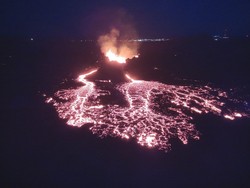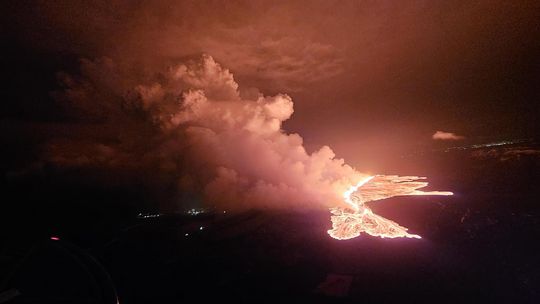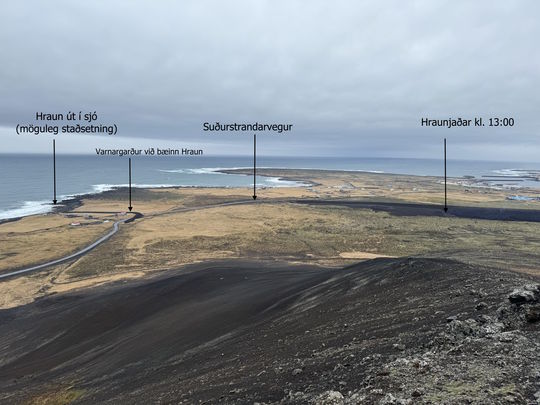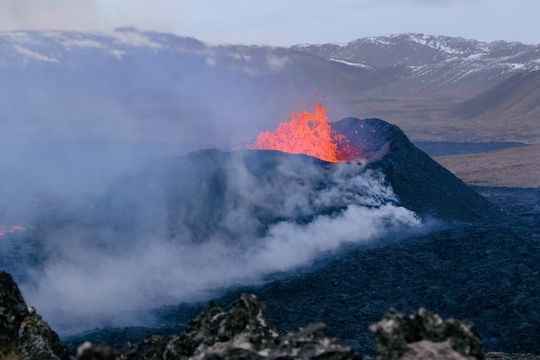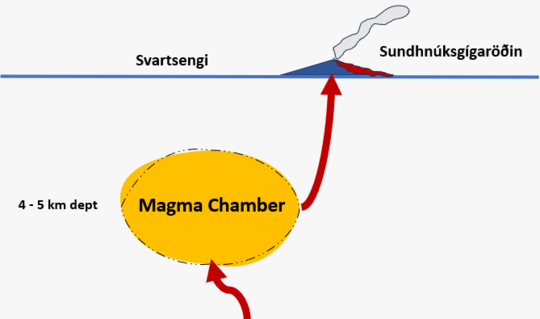One month since the start of the eruption at the Sundhnúkur crater row
Second longest eruption in the Reykjanes peninsula since 2021
Today marks one month since the beginning of the eruption that is ongoing at the Sundhnúkur crater row. The eruption, which began on the evening of March 16, is the fourth in a series of eruptions that started when magma began accumulating beneath Svartsengi in late October 2023.
The precursory signs of this eruption were short, with a small earthquake swarm starting around 7:30 PM and intensifying around 7:40 PM. GPS measurements subsequently exhibited signs of deformation, indicating the onset of a dike intrusion towards the Sundhnúkur crater row. The eruptive fissure that opened at 8:23 PM was approximately 3 km long and extended from Stóra-Skógfell to Sundhnúkur.
At the onset of the eruption, the lava primarily flowed southward and
southeastward, along the protective barriers towards Suðurstrandarvegur, and
northwestward towards Grindavíkurvegur. Approximately four hours after the eruption began, lava flowed over Grindavíkurvegur, just north of Svartsengi.
The speed of the lava flow, measured during surveillance flights conducted by the
Icelandic Coast Guard, was approximately 1 km per hour.
The volcanic plume over Svartsengi. Photo taken during the Coast Guard's first surveillance flight over the eruption site on 16 March. (Photo: Civil Protection/Björn Oddsson).
Concerns arose with the possible
scenario that, if the eruption's intensity remained unchanged, the lava might
reach the sea just east of Þórkötlustaðahverfi in Grindavík,.
In the case of lava reaching the seacoast, a localized hazard was expected due
to explosions and gas pollution, mainly hydrochloric acid (HCl). However, the
lava flow halted approximately 250 m from Suðurstrandarvegur
and has not advanced any further.
The progression of the lava flow towards Suðurstrandarvegur road was closely monitored due to the possibility of lava flowing over the road and even to the seacoast. Photo taken on 17 March.
As the night progressed, eruptive activity along the fissure diminished and consolidated into three locations. This initial development of the eruption closely resembled previous eruptions at the Sundhnúkur crater row, but its behavior diverged as the eruption slowed significantly. On the eleventh day of the eruption, only three vents remained active, with each extinguishing in succession until only one remained active on April 5. This vent, which is currently active, is located just east of Sundhnúkur, towards the southern end of the fissure that opened on the evening of March 16.
Photo taken from Sundhnúkur on 10 April showing the active crater. (Photo: Icelandic Meteorological Office/Jón Bjarni Friðriksson).
Second longest eruption in the Reykjanes peninsula since 2021
Compared to recent eruptions in the Sundhnúkur crater row during this phase of volcanic unrest, the current eruption exhibits the longest duration and is the second-longest on the Reykjanes Peninsula since 2021. Only the first eruption at Fagradalsfjall, which began in March 2021 and lasted for about 6 months, surpasses it. Comparatively, the Merardalir eruption in August 2022 lasted for 18 days, while the eruption at Litli Hrútur in July 2023 lasted for 26 days. The previous three eruptions at the Sundhnúkur crater row in December 2023, January 2024, and February 2024 were short-lived.
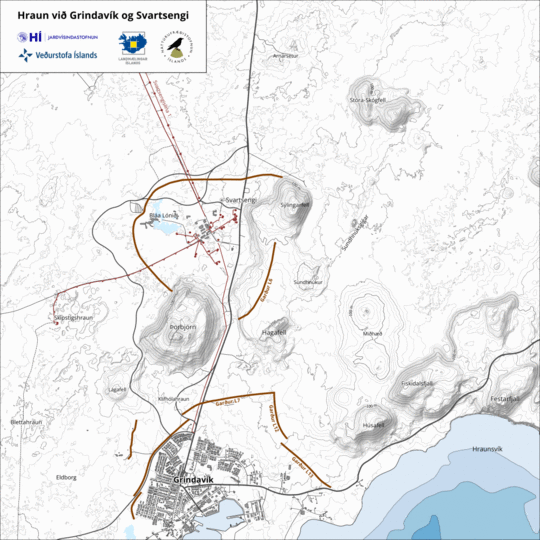
GIF Caption: the animated image shows the four lava
fields that have formed since December 2023, i.e. during the eruptions of 18-21
December 2023, 14-16 January 2024, 8-9 February 2024, and current eruption
which has been ongoing since 16 March. Based on measurements made on 8 April, the
lava field formed by the ongoing eruption covers about 6.14 km2.
As time passed and the eruption progressed, measurements revealed that land uplift had slowed down significantly and almost ceased, indicating that an equilibrium was between the inflow of magma into the magma reservoir and the extrusion of magma to the surface.
Since early April, the rate of uplift indicates that the majority of the magma flowing into the reservoir beneath Svartsengi started accummulating again, causing an increase in pressure and ground uplift while a reduced portion of the magma continues to flow to the surface at the Sundhnúkur crater row, as shown in the accompanying image.
A new trend to see a signal of land uplift in Svartsengi whilst an eruption is ongoing on the Sundhnúkur crater row
The sequence of events at the Sundhnúkur crater row may be compared to the events at Krafla that began in 1975. Over a 10-year period, Krafla experienced 20 dike intrusions, nine of which resulted in eruptions. During the unrest at Krafla, all intrusions entered the same magma chamber but varied in size. However, the Krafla eruptions did not occur at the regular intervals observed during the recent eruptions at the Sundhnúkur crater row. The consistency of the activity is unusual, with eruptions occurring at roughly one-month intervals since December 18, 2023.
Since December 2023, an unprecedented rhythm of events occurred, with repeated diking events and subsequent volcanic eruptions. The pattern of this eruptive sequence has been interrupted, given the March 2nd dike intrusion, which did not result in an eruption, and the long duration of the current eruption. Time will reveal when magma accumulation ceases in Svartsengi, and thereby the repeated diking events and volcanic eruptions in the area.
The relatively long duration of this eruption does not indicate that this sequence of events, which began in October 2023 with magma accumulation beneath Svartsengi, is ending; there are no signs that magma inflow rate from depth is diminishing. For reference, the volcanic unrest on Reykjanes between 2020 and 2022 exhibited four periods of magma accumulation beneath Svartsengi, with varying lengths of hiatus. Around 17 months then passed before magma accumulation, which is still ongoing, begun again at the end of October 2023.
The current situation, characterized by steady ground uplift in Svartsengi while an eruption in ongoing, is uncommon. It is important to closely monitor the area and react promptly to any changes in the activity to maintain the safety of people in the area and mitigate further damage.
